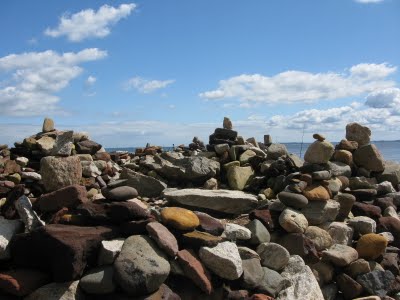A fascinating video of the movement of marble (a 12-minute-long YouTube video) in Carrara prompted this posting on the Herculean efforts that Michelangelo went through to move the same stone in the early 1600s. It is a slight adaptation from my book Stories in Stone.
In December 1516, Michelangelo convinced Pope Leo X and Cardinal Giulio de’ Medici that they should let him design a new façade for the church of San Lorenzo in Florence. The façade would be, he wrote to the Cardinal’s treasurer and liaison, Domenico Buoninsegni, “both architecturally and sculpturally, the mirror of all Italy.” Michelangelo proposed a more audacious undertaking than anything he, or anyone since antiquity, had done. The last great, full marble building in Rome had been built in 203 C.E, and the entire façade of San Lorenzo would be marble, including a dozen, monolithic columns.
Michelangelo’s initial task was to acquire the stone. He could have worked with a middle man, who would find, cut, and deliver marble, but Michelangelo didn’t trust the ones in Carrara and nearby Seravezza. They cheated him. They didn’t understand marble. They didn’t even know how to quarry marble, or so he wrote Buoninsegni. In order to ensure good rock during the years he worked on San Lorenzo, Michelangelo traveled to the quarries, or cave at Carrara and Seravezza 19 times and spent 18 months organizing and supervising an ever-changing group of helpers. At Seravezza, he also had to coordinate building and widening several miles of new road, part of which required men with picks to cut a route deep into the marble mountains.
After finding the right stone, Michelangelo would have hired a crew of cavatori or quarrymen, and scarpellini, or stone carvers to cut blocks out of the mountain. First, they cut a narrow trench, then they pounded in either iron or wood wedges and forced the stone to split into a clean face.
Marble did not leave the quarries as blocks; the notoriously penny-pinching Michelangelo wasn’t about to pay to transport any excess stone or for stone that might have hidden flaws. To aid the scarpellini in roughing out blocks, Michelangelo produced pages of drawings, often in multiple sets, detailing length, width, and breadth of the blocks. One book of his drawings shows 22 different shapes, many of which required several exact copies. The pages remind me of the shop tickets I saw at modern mills in Indiana and Minnesota.
[nggallery id=18]And then the fun began. Not only did Michelangelo have to figure out how to move his unwieldy blocks, by land, by sea, and by river, but he had to pay exorbitant fees. In ancient Greece, for example, transporting stone had cost ten times the cost of quarrying, and costs doubled for every 100 miles moved overland in Roman times. By Michelangelo’s day, fees had dropped, but still constituted a major cost of working in marble.
In moving stone, Michelangelo, and for that matter all movers of masses, had a simple goal, resist the pull of gravity. Any time gravity led a block astray catastrophe struck. A block could slide too quickly down a slope and maim or kill. A heavily laden cart could sink into a road built across a swamp. A block could drop from a hoist and turn a boat into driftwood. To counter the adverse and untimely affects of gravity, Michelangelo relied on rope and men. Neither came easily. He wrote his brother that if the Carrarese “are not fools, they are knaves and rascals.” A crew walked off the job taking the 100 ducats he had paid them and the ropes, one of which weighed 566 pounds for a 422-foot length, could take days to arrive from Pisa, Florence, or Genoa. Michelangelo’s detailed records show that rope accounted for 18 percent of the total transportation costs. He also had to borrow pulleys, buy wood for sleds, and order custom-made turnbuckles and iron rings.
With all of the equipment ready, the men could load the block… I will continue the story in my next posting.
